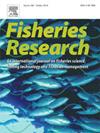Otolith shape analysis as a tool for species identification and management of cryptic congeners in the northern Benguela ocean warming hotspot
IF 2.2
2区 农林科学
Q2 FISHERIES
引用次数: 0
Abstract
Adaptive management is critical to maintaining resilient fisheries in our rapidly changing ocean environments. However, establishing appropriate and cost-effective monitoring programmes that adequately capture the responses of fisheries to climate change have been elusive. The coastal waters of central and northern Namibia are a global hotspot of ocean warming, with several responses by fish impacting its coastal fisheries. One documented change is a poleward distributional shift of the west coast dusky kob, Argyrosomus coronus into Namibia, where it has begun to hybridize with the congeneric A. inodorus. With considerably different life histories, it is critical that managers can differentiate between these species and the hybrids to appropriately manage the most important recreational and commercial linefish species (bycatch and biomass) in Namibia. In this paper, we used otolith shape analysis, Linear Discriminant Analyses (LDA) to show that otolith shape can be used to distinguish between species and their putative hybrids, identified based on mitochondrial DNA and nuclear microsatellite data. A total of 342 individuals from northern and central Namibia (northern Benguela) between 18.5 and 22.7°S were genetically identified, with a subsample of 217 paired with otolith shape analysis. Otolith shape analyses with LDA and leave-one-out cross validation showed successful species identification at 96.3 % accuracy, and improved accuracy of hybrid identification compared to using body morphology by 50 %. The Fourier descriptors provided excellent classification accuracy for separating A. coronus from A. inodorus (and putative hybrids, but poorer classification accuracy for separating the hybrids from A. inodorus (4/8). We thus recommend using otolith shape analysis for distinguishing the two species but suggest that genetic identification is still required to monitor hybridization. Monitoring for adaptive management should therefore include routine otolith collection and species classification to improve stock assessment and promote the development of appropriate management strategies for this important fishery in the northern Benguela.
求助全文
约1分钟内获得全文
求助全文
来源期刊

Fisheries Research
农林科学-渔业
CiteScore
4.50
自引率
16.70%
发文量
294
审稿时长
15 weeks
期刊介绍:
This journal provides an international forum for the publication of papers in the areas of fisheries science, fishing technology, fisheries management and relevant socio-economics. The scope covers fisheries in salt, brackish and freshwater systems, and all aspects of associated ecology, environmental aspects of fisheries, and economics. Both theoretical and practical papers are acceptable, including laboratory and field experimental studies relevant to fisheries. Papers on the conservation of exploitable living resources are welcome. Review and Viewpoint articles are also published. As the specified areas inevitably impinge on and interrelate with each other, the approach of the journal is multidisciplinary, and authors are encouraged to emphasise the relevance of their own work to that of other disciplines. The journal is intended for fisheries scientists, biological oceanographers, gear technologists, economists, managers, administrators, policy makers and legislators.
 求助内容:
求助内容: 应助结果提醒方式:
应助结果提醒方式:


